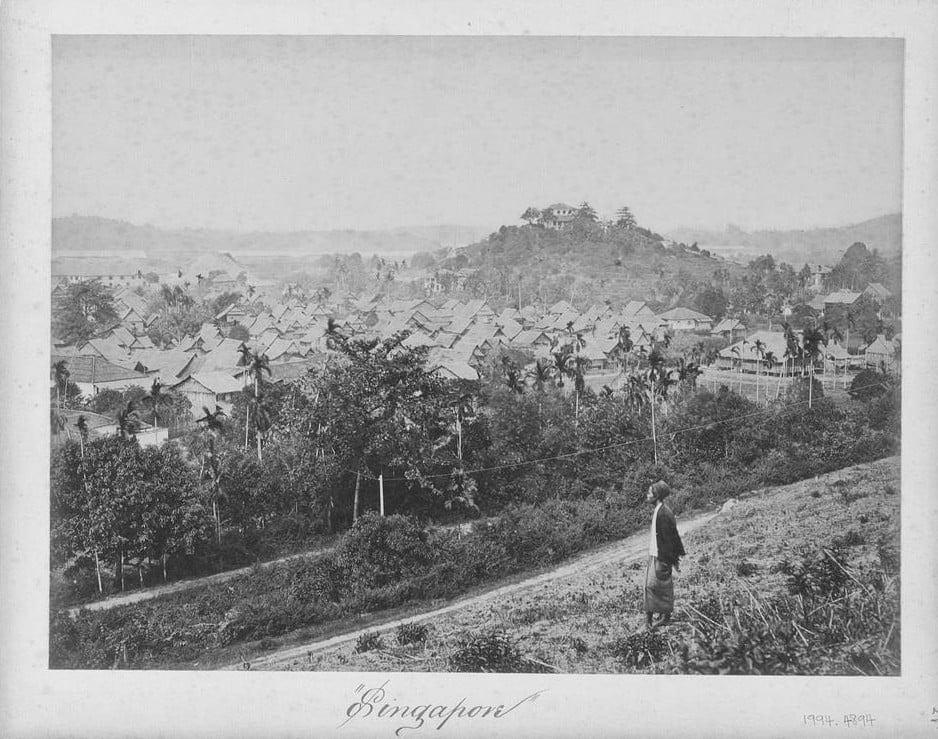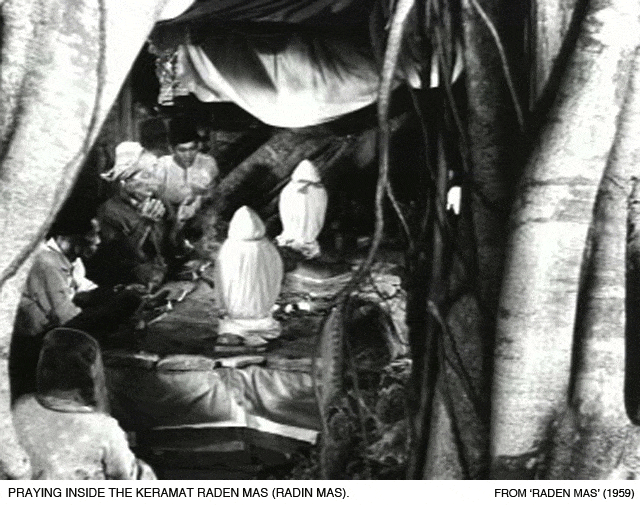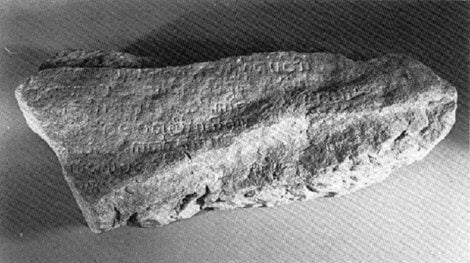Most Singaporeans are aware of the popular folktale of how the name Singapura came about, so I was told myths and legends of Singapore comfortably in a Grab car on the way out of Singapore airport. What a delightful welcome to the Lion City.
In this Article
Singapura, the Lion City

Singapore’s Myths and Legends – legend of Sang Nila Utama, that named the island Singapura – Lion City. – Stamp Set
It is said that long, long ago, a prince in Palembang called Sang Nila Utama was bored. He decided to go hunting with his men. In the woods they saw a deer, but as he tried to shoot, it moved swiftly. The prince and his men followed, trying to catch it. The deer disappeared, but from the hill where it had led them, the prince had a good view of the surrounding islands.
Looking out into the distance, Sang Nila Utama saw an island that he had not seen before. It had sands that shimmered white on the beach.
“What is that island?” he asked his men. “Temasek,” they answered. “Let us go there!” said the prince.
As they sailed towards Temasek however, a storm arose. The wind blew hard and the waves rose higher and higher. The boat was battered and in danger of capsizing. To lighten the load and help keep it afloat, Sang Nila Utama’s men began throwing overboard the cargo they carried. But still the storm
grew fiercer. They tried throwing everything that they could possibly manage without. They knew their lives were more important. However, the boat continued to sink.
One of his trusted advisers said to Sang Nila Utama,
“Throw your crown overboard! It is the heaviest thing left on board.” Perhaps the adviser had remembered an old story that said that Sang Nila Utama was one of the descendants of the Sea King’s daughter. When the prince threw his crown overboard, the storm abated and the seas were calm once again. So, they continued their journey.
When Sang Nila Utama and his men landed on the shores of Temasek, he caught sight of another animal, one that he had never seen before. It was magnificent with a black head, a white neck, and a red body. It looked deep into the prince’s eyes. Then it disappeared from view.

“What is that animal?” he asked his men.
No one really knew, but one of the ministers said, “I have heard that there is an animal that looks magnificent and regal like that. They call it singa or lion.”
Sang Nila Utama liked what he saw of the island. It was time he had his own place to rule and he thought the sighting of the singa was an auspicious sign. “This is where I shall live,” he said. “We shall call this place ‘Singapura’ -‘Lion City.’
And that, they say, is how Singapore got his name.
HISTORY: Singapore, a Pirate outpost
In the Sejarah Melayu, Malay Annals, Sang (Nila) Utama is a reference to a 13th-century Palembang prince from the Srivijaya ruling house. His link to the pre-1819 history of Singapore is his founding of a settlement called Singapura on the island Temasek sometime in 1299. The sighting of a lion by Sang Utama is often told to explain the renaming of Temasek to Singapura – “City of the Sea Lion” – the term singa- lion, has roots in Sanskrit; while pura is derived from the original Sanskrit term puram for city.
On founding Singapura, Sang Utama assumed the title of Sri Tri Buana (“Lord of Three Worlds” in Sanskrit). Sang Utama’s descendants ruled Singapore until the reign of Iskandar Shah, the fifth ruler of Singapore, who was driven out by the Majapahit (Javanese) forces and later founded the kingdom of Malacca (Malaysia). Thus the lineage of Malacca kings could be traced to Sang Nila Utama and all the way to the powerful Srivijaya.
According to the Portuguese, Parameswara was a nobleman from Palembang who fled from the chaos in his state and accepted the asylum offered by the chief of Singapore. Instead of showing gratitude, Parameswara killed his benefactor and, with the help of his followers and the Orang Laut (sea gypsies), captured power. Five years later, the relatives of the murdered chief took revenge and drove Parameswara out of Singapore. An ancestry linked to a “pirate prince” who murdered his host would have been a stain on the lineage of the Malacca kings. Thus the Parameswara past was left out and the record altered to make it appear that Iskandar Shah, the last ruler of Singapore and founder of Malacca, was a descendant of the Singapore royal lineage that could be traced to Sri Tri Buana.
Regardless of the myths and legends of Singapore, old sources have shown that the settlement of Temasek predates Parameswara’s adventure in the Malay Peninsula, though it was never more than a small outpost that was shadowed by pirates.
The Merlion

One night, the villagers living by the southern coast of Temasek were awakened by the howling winds and the crashing waves. The dark clouds blocked out the lights of the moon and the stars, turning the world in complete darkness. It was as though the island of Temasek would be engulfed by the raging sea. The terrified villagers sank on their knees in prayers.
During this moment, a bright light was observed emerging from the southern waters. A massive creature, half lion and half fish, roared in anger. The battle between the fierce mystical animal and nature was intense, as the sky was filled with flashing lightnings. The villagers had never witnessed such terrifying phenomenons before.
After some time, the winds began to die down, the waves subsided and the sky started to clear. The gigantic sea beast had won the battle against the nature. As it claimed its victory, it stood proudly on Mount Imbiah of Pulau Belakang Mati – Sentosa. By morning, the merlion had retreated into its waters, leaving behind a bright colorful trail.

Redhill and Tanjong Pagar

Singapore’s Myths and Legends – legend of Redhill, or Bukit Merah – Stamp Set
Along time ago, the southern coast of Singapore was infested by numerous fierce swordfish. The villagers and fishermen could not ply their trades at the sea, as they would be attacked by these fearsome creatures if they ever ventured near the waters. The people requested help from the Sultan, but even him and his royal army could not do anything about it.
“Father, look!” cried a young boy from the shore. His father, who was unraveling his fishing net, raised his anxious face to the blue sea that had suddenly turned silver. It was teeming with swordfish twisting and stabbing their way towards some fishermen’s boats out at sea.
The man dropped the net and ran to sound the village gong. By the time the Raja, Paduka Sri Maharaja, and his soldiers arrived to investigate, they were stunned by all the confusion and panic on the coast.
Men, women and children were screaming and weeping as the long blades of the swordfish shot out of the water and pierced right through the helpless fishermen, killing them all.

The swordfish then rocketed towards the villagers on the shore. “Run for your lives!” they screeched.
The Raja ordered his brave men to go down to the water. “Form a wall with your legs and fight the swordfish!” he commanded.
Unfortunately, even the Raja’s mighty army could not overcome the swordfish. Soon the gleaming sea turned to a bloody red as the swordfish slashed and sliced the men’s legs. When he saw his men groaning and writhing in pain, the Raja called for them to retreat.
The young boy who had first spotted the swordfish taunted, “Why do we make a wall with our legs? It will only hurt us. Why don’t we use banana tree trunks instead? That way, the swordfish will only hurt themselves!”
The Raja was secretly awed by the boy’s cleverness but his pride was wounded. Although he did not want to take the boy’s advice, he knew that it was the best solution. With much reluctance, he ordered the villages to fell as many banana trees as possible. When the tide was low, the people worked quickly to build a barricade along the seashore.
The soldiers and the people kept watch, armed with parangs and spears. The sluggish sea awoke again. It swelled and shimmered once more with what seemed like an even greater legion of swordfish. This time, the swordfish charged right into the trap and found their sharp bills stuck in the tree trunks!
The villagers leapt into the water and slaughtered the defenseless shoal of swordfish. The island celebrated the victory with a big feast and everyone sang a grateful toast to the boy who saved their lives.
Everyone except the Raja. Jealous and afraid that the people might think the boy more worthy of the throne, the Raja schemed to get rid of him. After the celebrations, he sent his men, cloaked in darkness, to the top of the hill where the boy lived.
There, they committed great evil by stabbing the boy until he died. But the blood of the boy did not remain on their hands alone. It spewed out from the wounds on his body and flooded the hill, turning it slowly into one bloody mound.
The mound later came to be known as Redhill or Bukit Merah. The name remains to this day in modern Singapore as an extraordinary memorial to the boy who was said to have saved his village a long time ago. In turn, the place where the barricade of banana tree trunks were set up became known as Tanjong Pagar, or “cape of stakes”.
Radin Mas
Pangeran Adipati Agung was the brother of a sultan in the kingdom of Java. He was an intelligent and courageous warrior, much loved by the people. He fell in love with the lead dancer of a dance troupe that had been invited to perform at the palace. As he could not marry a commoner, he wedded her in secret. Their happy union bore them a beautiful little girl whom they named Radin Mas Ayu, meaning “golden princess”.
Before long, the king found out and was extremely furious and plotted to punish the dancer. An opportunity arose when his kingdom was threatened by hostile invaders. The king sent Pangeran to quell the threat. The dancer saw it as a chance of reconciliation between her husband and his brother, the king, if he returned victorious. While Pangeran was away, however, the king had his men burn their house down. Pangeran’s wife perished but their daughter was rescued by a loyal servant. When Pangeran returned from a victorious battle and found out what had happened, he severed ties with his brother and the palace. He left the kingdom together with Radin Mas and the loyal servant.

The trio set sail and landed on the island of Singapore and settled down in a village at Telok Blangah. Pangeran was silent about his royal lineage and lived as other villagers did. The island was frequently harassed by sea pirates, and one day, Pangeran led a group of villagers to defeat them. News of Pangeran’s valour reached the Sultan of Singapore, who invited the former to the palace. It happened that an envoy from Java was also at the palace to meet the Sultan, and was surprised to see Pangeran. He informed the Sultan of Pangeran’s identity. The Sultan was delighted to know that Pangeran was a prince and arranged for his princess to be wedded to him.
Pangeran agreed to the marriage and a son was born to them. He was named Tengku Chik Meanwhile Radin Mas had grown into a beautiful woman, and her stepmother was jealous both of her beauty and closeness with her father. One day, little Tengku Chik accidentally cut his foot on a piece of broken plate dropped by Radin Mas. Her stepmother accused her of deliberately harming Tengku Chik, but Pangeran refused to believe it was done on purpose. To get even with Radin Mas, her stepmother together with her stepmother’s nephew, Tengku Bagus, plotted against Pangeran and Radin Mas. Her stepmother knew that Tengku Bagus was in love with Radin Mas and wished to marry her. With Radin Mas married, she would no longer have to compete with her for Pangeran’s attentions.
Tengku Bagus got Pangeran intoxicated on drugged wine, and held him prisoner in an unused deep well. The next day, Tengku Bagus proposed to Radin Mas, threatening to kill Pangeran if she refused to marry him. During the solemnization ceremony however, Radin Mas was asked if she had her father’s permission to marry. Fearful for her father’s life, she lied, saying that he had died while visiting Java. At this instant, Tengku Chik blurted out that he had seen their father alive in the unused well. The plot was revealed and Pangeran was rescued.
Afraid of Pangeran’s revenge, Tengku Bagus drew his kris and lunged at him. Radin Mas sprang forward to shield her beloved father and the kris plunged into her heart, killing her. Her stepmother stole away during the commotion, but just as she was slipping away, lightning struck and killed her.
Keramat Radin Mas is the shrine of Radin Mas Ayu, a Javanese princess who shielded her father from being killed, only to be killed herself.According to the legend, Radin Mas was a beautiful and filial daughter loved by her father but hated by her stepmother. Radin Mas was brought to Singapore by her father as an infant, and lived in a village at Telok Blangah. Her father, a skillful warrior prince, married into the royal family in Singapore. How much of the legend is true is unclear.

However, the tomb and a shrine, locally known as Makam Puteri Radin Mas, still stands today at Mount Faber Road, near the junction with Telok Blangah Road, behind Mount Faber Lodge Condominium, and still receives visitors. There was an old village mosque nearby that also bore her name. It was, however, removed in 2001 to extend the road going up to Mount Faber.
In the past, the tomb was enclosed by the roots of two banyan trees. The trees were removed in 2010 as they were thought to have been diseased and any falling branches would have been a danger to visitors. There used to be a spring close to the foot of Mount Faber, and its water was believed to have healing properties. When the spring became too popular and visitors seeking healing began disturbing local residents, the police had the water piped underground and covered the area in cement.
Pulau Ubin
A legend explains that in the early days, an elephant, a pig and a frog challenged one another to reach the Johor shores from mainland Singapore. The stakes were high, as those who did not succeed would be turned into rock. The frog, being the first to try, failed to cross the straits and was turned into Pulau Sekudu. Pulau Sekudu literally means Frog Island in Malay.
The elephant and the pig were the next to attempt the feat. They did not make it too, thus both of them fused together to become the main island of Pulau Ubin.
Pulau Ubin is located on the north-eastern coast of Singapore, with Selat Johore to the north and Serangoon Harbour to the south. Its name is derived from its original Malay name, Pulau Batu Jubin, which means “Island of Granite Stones”. Granite quarries provided the initial draw for early local settlement, and much of the island’s granite was used for Singapore’s early developments.
Pulau Blakang Mati
The former name of Sentosa was Pulau Blakang Mati, where Blakang Mati means “behind the dead” in Malay.
No one knows exactly how the name of the island came about, but there were many legends about its origin. According to one version, the island was once a place of piracy and bloodshed in the past. The victims of the murders haunted the island so much that it was given this not-so-auspicious name. Another account was that the island was located “behind” Pulau Brani, which was the burial ground of many ancient Malay warriors.
Nevertheless, Pulau Blakang Mati was renamed as Sentosa (which means “isle of tranquility”) in 1972. With the island becoming a favourite beach resort among Singaporeans and the tourists, the unhappy legends were soon forgotten.
Sisters’ Islands

According to legend, there was a poor widow who had two pretty daughters, Minah and Linah.
The sisters were so close that they vowed to marry two brothers so they could always live together. When the news spread, many suitors came but none were brothers. A year later, the widow died and the sisters left the village to live with a distant uncle.
One day, Linah met a group of pirates while fetching water from a well near the sea. The pirate chief was surprised to see such a beautiful girl and approached her immediately. Frightened, she ran home. He pursued her and at her uncle’s home, brandished a dagger as he made known his wish to marry Linah.
That night, the two sisters wept bitterly in each other’s arms. When dawn broke, the pirate chief and 16 of his men came to take Linah away. The sisters clung to each other but were forced apart by the pirates. Minah was pushed to the ground and Linah was hoisted over the pirate chief’s shoulders. Minah swam after the boat but was swept under by a wave. Linah broke free from the pirate and threw herself overboard. Just then a storm broke and raged until the next day.
When it stopped, two islands stood at the spot where the sisters had drowned. Villagers named the landmark Sisters’ Islands.
Sisters’ Islands is located south of Singapore and is made up of two islands that are separated by narrow but deep channels. The islands are individually known as Pulau Subar Darat (Little Sister’s Island) and Pulau Subar Laut (Big Sister’s Island).
Kusu Island

Kusu Island is located 5.6 km south-west of Singapore. A Chinese temple and three Malay keramat (shrine) on the island attract thousands of pilgrims annually, especially in the 9th lunar month that falls between September and October.
Kusu means “tortoise” or “turtle” in the Hokkien dialect. The island is also known as Pulau Tambakul (or Tembakul), Goa Island or Peak Island.
There are many legends surrounding the island, but they revolve mainly around the image of a giant turtle and of the friendship between two men, one Malay and the other Chinese.
- During the 9th lunar month, a huge turtle saved a group of sailors from the rough seas by turning itself into an island. The grateful sailors returned there the following year to make offerings of thanksgiving. Since then, the island has been treated as sacrosanct, and has become a place of worship.
- Two fishermen had wrecked their boat while plying the waters near Kusu. Upon seeing their plight, a giant turtle transformed itself into an island to provide sanctuary for the shipwrecked fishermen to land on.
- A sailing boat foundered near Kusu Island, and went down with the strong waves. Two survivors, a Chinese and a Malay, swam ashore. Stranded on the island, they lived on shrubs and wild shoots to survive. Their friendship lasted until they died. Years later, when a ship plagued by an epidemic dropped anchor near the island, the scourge miraculously disappeared, and the sick regained their health.
- About 170 years ago, two holy men, Dato Syed Abdul Rahman, an Arab, and Yam, a Chinese, meditated and fasted on their pilgrimage to Kusu. Yam fell ill during the journey, and Syed prayed fervently for him. The sudden appearance of a boat with food and water saved both their lives. The grateful pair returned to Kusu regularly as a gesture of gratitude. When they died, they were buried next to each other on the island. Later, the Tua Pek Kong Temple and the Malay shrine were erected, and dedicated to their memory.
Selegie Road
The legend about Selegie Road is that it was the location of many great battles that took place in ancient Singapore. When Temasek fell in 1377, the last ruler of the kingdom was believed to have fled via this road, still a dirt track then, to Seletar. He escaped by the waters at the coast of Seletar and never managed to launch a comeback in a bid to reclaim his territories.
In the later years, a Bugis pirate tribe known as Orang Selegie was said to have occupy the area around Selegie, where they made Mount Sophia their home. The name Selegie may mean a Malay word that refers to a sharpened and hardened wooden spear.
Badang and the Singapore Stone

According to local Malay folklore, Badang began as a poor fisherman who plied his trade at mouth of the Singapore River. One day he caught a genie in his fishing net, and in return of his release, the genie granted Badang’s wish to be the strongest man alive.
Impressed with Badang’s enormous strength, the Rajah of Singapura appointed him as the imperial warrior. Soon, other kingdoms heard of Badang’s fame and sent their warriors to challenge him. The king of India, in particular, sent his kingdom’s strongest man Wadi Bijaya to Singapura for a duel. In the last contest, Badang beat Wadi Bijaya by lifting a huge rock and throwing it towards the Singapore River.
Ancient inscriptions were added to the rock, probably to commemorate Badang’s achievements but centuries later in 1843, the British colonial government blasted it to pieces. Known as the Singapore Stone, only a fragment remains, and is now kept in the Singapore History Museum, where I saw it.
~ ○ ~
Keep exploring:
Works Cited & Multimedia Source
- 10 Legends and Myths of Singapore. – Remembersingapore.
- Nor Afidah Abd Rahman.
- http://eresources.nlb.gov.sg/infopedia/articles/SIP_93_2005-01-26.html?s
- Sang Nila Utama. – Singapore Infopedia.
- Lim Charlotte.https://roots.sg/learn/stories/attack-of-the-swordfish/story
- Attack of the Swordfish And Other Singapore Tales.
- Omar Marsita. Keramat Radin Mas. – Singapore Infopedia.
- Vernon Cornelius. Sisters’ Islands. – Singapore Infopedia.
- Vernon Cornelius-Takahama. Kusu Island. – Singapore Infopedia.


